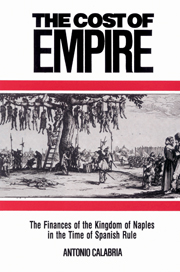Book contents
- Frontmatter
- Contents
- List of figures
- Acknowledgments
- List of abbreviations
- Weights and measures
- Monetary units and exchange rates
- Maps
- Introduction
- 1 The early modern Southern Italian economy
- 2 The fiscal system in early modern Naples
- 3 Government income, 1550–1638
- 4 Government expense, 1550–1638
- 5 The creation of a securities market in the later sixteenth century
- Conclusion
- Appendix I The tables
- Appendix II The sources
- Bibliography
- Index
- Cambridge Studies in Early Modern History
3 - Government income, 1550–1638
Published online by Cambridge University Press: 13 November 2009
- Frontmatter
- Contents
- List of figures
- Acknowledgments
- List of abbreviations
- Weights and measures
- Monetary units and exchange rates
- Maps
- Introduction
- 1 The early modern Southern Italian economy
- 2 The fiscal system in early modern Naples
- 3 Government income, 1550–1638
- 4 Government expense, 1550–1638
- 5 The creation of a securities market in the later sixteenth century
- Conclusion
- Appendix I The tables
- Appendix II The sources
- Bibliography
- Index
- Cambridge Studies in Early Modern History
Summary
The preceding chapter focused on elements of continuity and change in the fiscal administration of the Kingdom of Naples in the early modern era and showed that both tradition and innovation were the hallmarks of the Spanish presence in Southern Italy. The Neapolitan fiscal system underwent little structural innovation in the two centuries of direct Spanish rule. Significant change did come to the Kingdom during that time, however, and it concerned the intensity and rhythms of fiscal pressure as well as the introduction of certain expedients, such as the creation of a market in government securities, which greatly expanded the state's return from the yield of taxation.
Though from a different perspective, this chapter too will be concerned with both continuity and change. Its aim is to trace the history of government income in Naples from the 1550s to the 1630s, and to do so in quantitative terms. It will therefore concentrate on innovation, on the results of fiscal policies which sought to increase state revenue in the face of mounting commitments in several theaters.
The story this chapter will tell is, of course, grounded in the specific historical context of the Kingdom of Naples in the sixteenth and seventeenth centuries. But in its general outline at least, it is a story of much wider resonance than that, because the fiscal and financial problems of the Kingdom of Naples were also those of Spain and of many other states in Europe in an age of rising prices and of increasingly expensive warfare.
- Type
- Chapter
- Information
- The Cost of EmpireThe Finances of the Kingdom of Naples in the Time of Spanish Rule, pp. 54 - 75Publisher: Cambridge University PressPrint publication year: 1991

